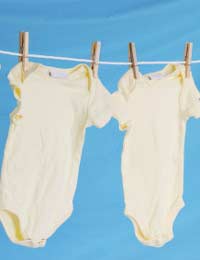Sourcing Suitable Fabrics for Children's Clothes

People who make children's clothes tend to be highly imaginative, and it's easy to make a bee line for bright colours and exciting patterns. But children's clothes - especially those designed for babies and toddlers - can't be made out of just any kind of fabric. They have to be tough to survive children's exploits and, of course, they have to be safe. How can you be sure you're making the right choices?
Suitable fabrics for children's clothing can normally be obtained from ordinary clothing wholesalers, but it's all the more important for you to know what you're doing and know exactly what you're buying.
Sensitive Skin
The younger a child is, the more delicate their skin is likely to be, and the more sensitive they will be to the types of fabric they wear. It's really important to avoid triggering allergies in children because these can set the pattern for the rest of their lives. What's more, children are more likely to suffer from problems such as eczema which can make rough fabrics painful to wear.The first rule of choosing fabrics for children is to make them soft and breathable.
Avoid anything that might abrade the skin and avoid fabrics like nylons which can trap sweat, triggering allergies and infections. Bear in mind that wool, which you might think of as soft, has lots of tiny hooks which can damage the skin; however, wool is a good insulator and soft, high quality wools can still be a good choice for warm children's clothes.
Metallic fabrics often cause allergies, it's a good idea to avoid them in children's clothes unless they're lined with a layer of different fabric. Don't use them where they'll press against the skin.
Wear And Tear
Fortunately, soft fabrics don't have to be delicate fabrics. Although young girls often express a desire for everything to be delicate, children's clothes really can't be made that way, as they're going to be subjected to a lot of abuse. The chances are that they are going to be worried at, pulled, dragged along the carpet, soaked in mud, and subjected to all manner of stains from food and drink. Depending on the age of the child, they may also be licked, sucked and urinated upon.Children's clothes have to be resilient enough to resist tearing when subjected to strain. If you can find it, a fabric with a bit of stretch to it is always a good choice. They also need to be strong enough to cope with frequent washing, and they must not contain dyes that will leak out when soaked with water, food oils, saliva or urine.
If your wholesaler isn't sure about these things, ask for sample swatches of fabric which you can test before you agree to buy in bulk.
Fire Safety
As children are less safety-conscious than adults, their clothes need to be safer to wear.Children's clothes should never be made using highly flammable fabrics - most synthetics. If you feel it's essential to incorporate fabrics like these into a special garment such as a party costume, you should attach a warning label where it will be clearly visible to parents. Be especially wary of such fabrics in trailing portions of clothes which are more likely to get caught on hot things by accident.
Buttons, Zips And Trimmings
Just as fabrics for children's clothes need to be chosen carefully, so do their trimmings. Buttons and trimmings must be carefully secured to prevent younger children tearing them off and eating them, and to prevent older children losing them.Plastic zips are better than metal ones, and metal ones should be covered by a flap of cloth on the inside of the garment, to prevent allergies and stop skin getting caught in them.
Children love velcro, which makes it easy for them to fasten and unfasten garments quickly, but you should be careful what fabrics you use this with as it can quickly damage and tear them. When choosing buttons, toggles and other fasteners for small children, remember that larger items are easier for small hands to operate.
By sourcing the right fabrics for children's clothes, you can make sure that your products and comfortable and safe and that they really last. This can help you to build up a strong reputation and keep customers coming back for more as their children grow.


Re: Selling Your Fashion Designs Online
Hi how can i sell my designs while being a student in the 10th grade
Re: Basic Equipment for Starting up a Fashion Business
I want to start small business as a student and also fashion designer, and I don't have much money for…
Re: Basic Equipment for Starting up a Fashion Business
I'm a fashion designer, I want to start a fashion school, I want to know the necessary requirements to…
Re: Basic Equipment for Starting up a Fashion Business
I am a fashion designer and I am working on having my own fashion brand,please what are the necessary…
Re: Basic Equipment for Starting up a Fashion Business
I am an up coming fashion designer,I want to start my personal clothing brand. Please what are the…
Re: Basic Equipment for Starting up a Fashion Business
What can 30,000 do for fashion designing business Why you need an additional tools
Re: Keeping Records of Your Patterns and Fabrics
Can anyone tell me the type of records to be kept as a garment maker?
Re: Selling Your Fashion Designs Online
Hi I'm not a professional designer, but I have doing many sketches of trending dresses. I'm wondering how can I sell them…
Re: Selling Your Fashion Designs Online
Hi there, I'm not a fashion designer too I just started my intermediate and I do have many designs of beautiful outfits I…
Re: Selling Your Fashion Designs Online
Hie, I'm a fashion designer, I need help pliz... I would like to make a sale of my sketches online.